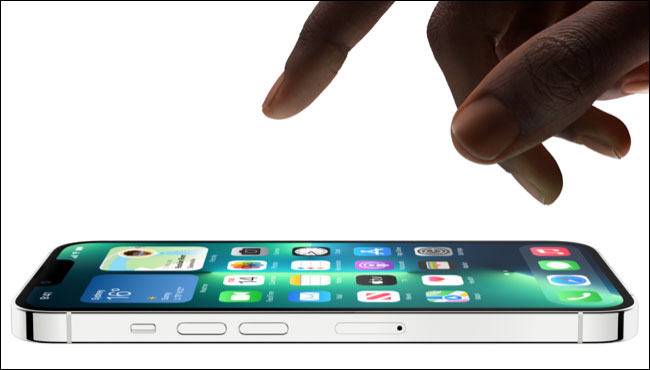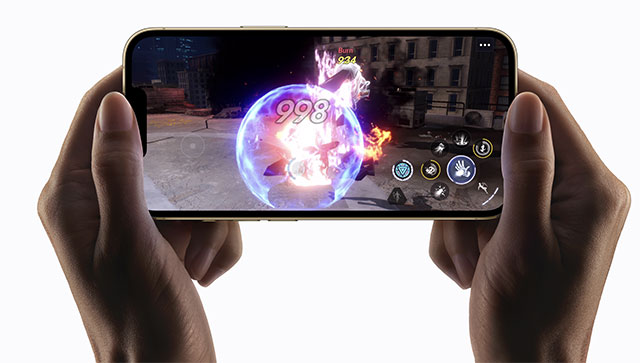What is the ProMotion screen on the iPhone? How does it work?
It is quite unfortunate that this technology is only equipped by Apple on the iPhone 13 Pro and iPhone 13 Pro Max duo. But it also shows that this is a worthwhile technology, only equipped on really high-end products.
So what is the ProMotion monitor? How does it work? Find out below.
ProMotion 120Hz . display
The first condition that a ProMotion panel needs to meet is that it must possess a maximum refresh rate of not less than 120Hz. Refresh rate (or refresh rate) refers to the number of times the screen updates per second. The higher the refresh rate, the smoother and more flattering every movement on the screen is, so the user experience will also be better.
In fact, all Apple devices that do not use ProMotion screens at the moment only have a refresh rate that stops at 60Hz, which is half the 'smoothness' of ProMotion panels.

The second factor, and also the most valuable, is that the ProMotion display possesses flexible adaptability. This means they can change the refresh rate to suit each task and the specific content being displayed. During gaming, for example, you can use the full 120Hz refresh rate for the smoothest possible experience. But if you are simply reading a book, you can reduce the refresh rate accordingly as well as save battery.
In addition, ProMotion also allows to boost the refresh rate on a specific area of the screen instead of the entire screen. Therefore, when you surf the web, play 3D games, or draw with Apple Pencil, that area of the screen will have a higher refresh rate, feeling noticeably smoother, faster, and more accurate.
This is why the ProMotion screens on the iPhone 13 Pro and iPhone 13 Pro Max are advertised as having a refresh rate range of 10Hz to 120Hz. At the lowest refresh rate, the screen will update just 10 times per second - 'super jerky' but super battery efficient - and vice versa.
Benefits of ProMotion monitors
As mentioned, the obvious benefit of a higher refresh rate is smoother on-screen motion in all situations. When you double the refresh rate, you effectively double the amount of response your taps and swipes generate.
This leads to a more pleasant user experience when performing various tasks. In gaming, 120Hz can even give you an edge, as you get twice the frame rate compared to a 60Hz monitor (theoretically). Of course this only happens if the tablet or smartphone has a GPU powerful enough to handle the high refresh rate.

Drawing with Apple Pencil also benefits from a higher refresh rate, as there is a lower latency (only 20ms on the latest models). This results in a much more natural writing and drawing experience, as if you were writing on real paper.
Having the monitor adjust the refresh rate based on each task also saves battery life by avoiding using high refresh rates when not needed. For example, iPhone will reduce the refresh rate when you're viewing a still photo, then automatically revert it back to "smooth" when you swipe to the next photo.
This is similar to the Variable Refresh Rate technology currently common on most gaming monitors, the only difference is that gamers use this technology to eliminate 'tearing', not to save money. the battery.
Android smartphone manufacturers have been equipped with 120Hz screens on their products for a long time. Therefore, the fact that Apple equips ProMotion panels on iPhone is a logical step, helping the product not to lag behind competitors in the market.
You should read it
- iPhone 12 Pro will have a 120Hz ProMotion display, a bigger battery, an improved Face ID and a 3x optical zoom camera
- 120Hz screen will be equipped for all 14 . iPhone models
- How to use promotion account Mobi, Viettel, Vina to register 4G
- How to receive up to 20 GB data when loading card for MobiFone
- How to enter promotion code on Go viet
- Apple allows replacing iPhone 5s screen
- Acronis special discount promotion for the second quarter of 2014
- Prepaid mobile subscribers are only entitled to a promotion of up to 20% from 1/3/2018
May be interested
- IBM announces next generation Z processor: 7nm Telum chip, 22.5 billion transistors, 8 cores running on 5GHz clock
 ibm has just released relatively detailed information about its next-generation telum chipset, which is part of the new z series of processors. the telum chip carries a completely new core architecture design, aimed at radically enhancing ai processing capabilities.
ibm has just released relatively detailed information about its next-generation telum chipset, which is part of the new z series of processors. the telum chip carries a completely new core architecture design, aimed at radically enhancing ai processing capabilities. - Based on GPT-3, they have developed a tool that can turn your commands into lines of code
 ai research company openai has just launched a new machine learning tool that can convert english sentences into lines of code. new tool called codex developed by openai.
ai research company openai has just launched a new machine learning tool that can convert english sentences into lines of code. new tool called codex developed by openai. - Microsoft launches Windows 365, a cloud operating system that can run on any device
 we've heard microsoft claim that the future of technology is cloud computing. the software giant has also brought a lot of its services to the cloud, such as the office 365 office package or the xbox cloud gaming cloud gaming service.
we've heard microsoft claim that the future of technology is cloud computing. the software giant has also brought a lot of its services to the cloud, such as the office 365 office package or the xbox cloud gaming cloud gaming service. - Intel announces new SSD with Optane Memory and NAND flash
 optane memory h20 is the sequel to 2019's optane memory h10, combining 3d xpoint-based optane memory technology and 3d qlc nand flash on a single m.2 card.
optane memory h20 is the sequel to 2019's optane memory h10, combining 3d xpoint-based optane memory technology and 3d qlc nand flash on a single m.2 card. - The world's smallest chip, fits in a needle to inject into the body
 recently, engineers from columbia university, new york have successfully created the world's smallest chip with a volume of less than 0.1 mm3, equivalent to a dust mite.
recently, engineers from columbia university, new york have successfully created the world's smallest chip with a volume of less than 0.1 mm3, equivalent to a dust mite. - Is investing TKO on Tokocrypto potential?
 tokocrypto (tko) is indonesia's first regulated cryptocurrency exchange, offering a unique token model with utilities ranging from tokens on exchanges, to cefi and defi. so is the investment in tko on tokocrypto potential? are there any risks?
tokocrypto (tko) is indonesia's first regulated cryptocurrency exchange, offering a unique token model with utilities ranging from tokens on exchanges, to cefi and defi. so is the investment in tko on tokocrypto potential? are there any risks?






 Hunting promotion news to load scratch cards on iPhone in 4 steps
Hunting promotion news to load scratch cards on iPhone in 4 steps Leaked information about iPhone 2020 with drastic improvements in visibility
Leaked information about iPhone 2020 with drastic improvements in visibility Why the touch screen does not work and how to fix it
Why the touch screen does not work and how to fix it How to fix iPhone touch screen not working
How to fix iPhone touch screen not working IPhone screen X: Size and special features
IPhone screen X: Size and special features